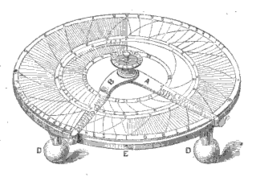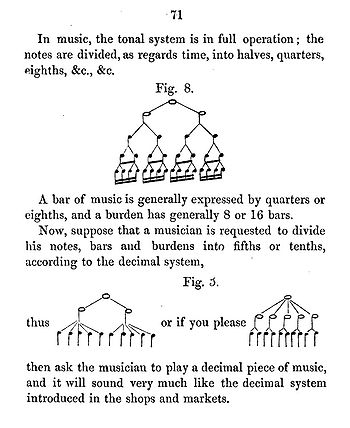
John W. Nystrom
Encyclopedia

Civil engineer
A civil engineer is a person who practices civil engineering; the application of planning, designing, constructing, maintaining, and operating infrastructures while protecting the public and environmental health, as well as improving existing infrastructures that have been neglected.Originally, a...
, inventor and author
Author
An author is broadly defined as "the person who originates or gives existence to anything" and that authorship determines responsibility for what is created. Narrowly defined, an author is the originator of any written work.-Legal significance:...
who lived in Philadelphia, Pennsylvania
Pennsylvania
The Commonwealth of Pennsylvania is a U.S. state that is located in the Northeastern and Mid-Atlantic regions of the United States. The state borders Delaware and Maryland to the south, West Virginia to the southwest, Ohio to the west, New York and Ontario, Canada, to the north, and New Jersey to...
.
Inventions and Patents
Nystrom received many patentPatent
A patent is a form of intellectual property. It consists of a set of exclusive rights granted by a sovereign state to an inventor or their assignee for a limited period of time in exchange for the public disclosure of an invention....
s for inventions such as a marine steam engine
Marine steam engine
A marine steam engine is a reciprocating steam engine that is used to power a ship or boat. Steam turbines and diesel engines largely replaced reciprocating steam engines in marine applications during the 20th century, so this article describes the more common types of marine steam engine in use...
, a refrigerator
Refrigerator
A refrigerator is a common household appliance that consists of a thermally insulated compartment and a heat pump that transfers heat from the inside of the fridge to its external environment so that the inside of the fridge is cooled to a temperature below the ambient temperature of the room...
, and calculating machines. His slide ruler invention (U. S. patent #7961) was filed with the United States Patent Office on March 4, 1851.
Nystrom is most noted for his proposal to switch from base 10 to base 16 as defined in his 1862 publication titled Project of a New System of Arithmetic, Weight, Measure and Coins, Proposed to be Called the Tonal System, with Sixteen to the Base.
Tonal System (Hexadecimal)

Hexadecimal
In mathematics and computer science, hexadecimal is a positional numeral system with a radix, or base, of 16. It uses sixteen distinct symbols, most often the symbols 0–9 to represent values zero to nine, and A, B, C, D, E, F to represent values ten to fifteen...
(base 16) system of notation, arithmetic
Arithmetic
Arithmetic or arithmetics is the oldest and most elementary branch of mathematics, used by almost everyone, for tasks ranging from simple day-to-day counting to advanced science and business calculations. It involves the study of quantity, especially as the result of combining numbers...
, and metrology
Metrology
Metrology is the science of measurement. Metrology includes all theoretical and practical aspects of measurement. The word comes from Greek μέτρον , "measure" + "λόγος" , amongst others meaning "speech, oration, discourse, quote, study, calculation, reason"...
called the Tonal System. In addition to new weights and measures, his proposal included a new calendar
Calendar
A calendar is a system of organizing days for social, religious, commercial, or administrative purposes. This is done by giving names to periods of time, typically days, weeks, months, and years. The name given to each day is known as a date. Periods in a calendar are usually, though not...
with sixteen months, a new system of coinage
Currency
In economics, currency refers to a generally accepted medium of exchange. These are usually the coins and banknotes of a particular government, which comprise the physical aspects of a nation's money supply...
, and a hexadecimal clock
Hexadecimal time
Hexadecimal time is the representation of the time of day as a hexadecimal number in the interval [0,1). The day is divided in 1016 hexadecimal hours, each hour in 10016 hexadecimal minutes and each minute in 1016 hexadecimal seconds.This time format was first proposed by the...
with sixteen hours in a day.
"I am not afraid, or do not hesitate, to advocate a binary system of arithmetic and metrology. I know I have nature on my side; if I do not succeed to impress upon you its utility and great importance to mankind, it will reflect that much less credit upon our generation, upon scientific men and philosophers."
(Quotation: John W. Nystrom, ca. 1863)
He proposed names for the hexadecimal digits, calling zero "noll" and counting (from one to sixteen):
"An, de, ti, go, su, by, ra, me, ni, ko, hu, vy, la, po, fy, ton." (Therefore tonal system.)
Because hexadecimal requires sixteen digits, Nystrom supplemented the existing decimal digits 0 through 8 with his own invented characters. (These can be seen on his clockface at right.) Modern users of hexadecimal overcome this same obstacle by using the digits 0 through 9 followed by the letters A through F.
The numbers 1116 and 1216 would be said "tonan", "tonde", etc. The table below shows Nystrom's names for successive powers of 1016.
| Base 16 Number | Tonal Name | Base 10 Equivalent |
|---|---|---|
| 10 | ton | 16 |
| 100 | san | 256 |
| 1000 | mill | 4,096 |
| 1,0000 | bong | 65,536 |
| 10,0000 | tonbong | 1,048,576 |
| 100,0000 | sanbong | 16,777,216 |
| 1000,0000 | millbong | 268,435,456 |
| 1,0000,0000 | tam | 4,294,967,296 |
Thus, the hexadecimal number 1510,0000 would be "mill-susanton-bong". This first hexadecimal system, proposed in the 19th century, has thus far not achieved widespread usage.


Duodenal System (Duodecimal)
By 1875, Nystrom had abandoned his Tonal System, and proposed a new proposed duodecimalDuodecimal
The duodecimal system is a positional notation numeral system using twelve as its base. In this system, the number ten may be written as 'A', 'T' or 'X', and the number eleven as 'B' or 'E'...
(base 12) system of notation, arithmetic
Arithmetic
Arithmetic or arithmetics is the oldest and most elementary branch of mathematics, used by almost everyone, for tasks ranging from simple day-to-day counting to advanced science and business calculations. It involves the study of quantity, especially as the result of combining numbers...
, and metrology
Metrology
Metrology is the science of measurement. Metrology includes all theoretical and practical aspects of measurement. The word comes from Greek μέτρον , "measure" + "λόγος" , amongst others meaning "speech, oration, discourse, quote, study, calculation, reason"...
called the Duodenal System as an appendix in his book "A New Treatise on Elements of Mechanics Establishing Strict Precision in the Meaning of Dynamical Terms".
Selected works
- A treatise on screw propellers and their steam-engines, with practical rules and examples how to calculate and construct the same ... accompanied with A treatise on bodies in motion in fluid ... also, a full description of a calculating machine (Philadelphia: H. C. Baird. 1852)
- Project of a new system of arithmetic, weight, measure and coins, proposed to be called the tonal system, with sixteen to the base (Philadelphia: J.B. Lippincott & Co.; London: Trubner & Co. 1862)
- On technological education and the construction of ships and screw propellers, for naval and marine engineers (Philadelphia: H.C. Baird. 1866)
- Informe al supremo gobierno del Perú, sobre una espedición al interior de la república (Lima: E. Prugue. 1868) Spanish
- Pocket-book of mechanics and engineering (Philadlephia: J. B. Lippincott & co.; London: Trübner & Co. 1869)
- Principles of dynamics (Philadelphia: J. P. Murphy, printer. 1874)
- A new treatise on elements of mechanics establishing strict precision in the meaning of dynamical terms accompanied with an appendix on duodenal arithmetic and metrology (Philadelphia: Porter & Coates. 1875)
- A new treatise on steam engineering, physical properties of permanent gases, and of different kinds of vapor (Philadelphia: London: J.B. Lippincott & Co. 1876)
External links
- Nystrom, John W. Project of a New System of Arithmetic, Weight, Measure and Coins, Proposed to be Called the Tonal System, with Sixteen to the Base
- Nystrom, John W. On a new system of arithmetic and metrology, called the tonal system Part 1,Part 2,Part 3
- Nystrom, John W. A New Treatise on Elements of Mechanics Establishing Strict Precision in the Meaning of Dynamical Terms

